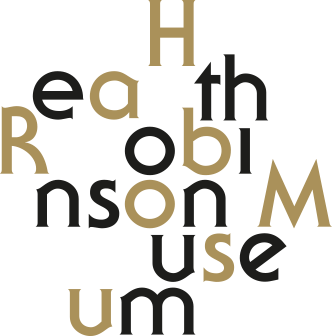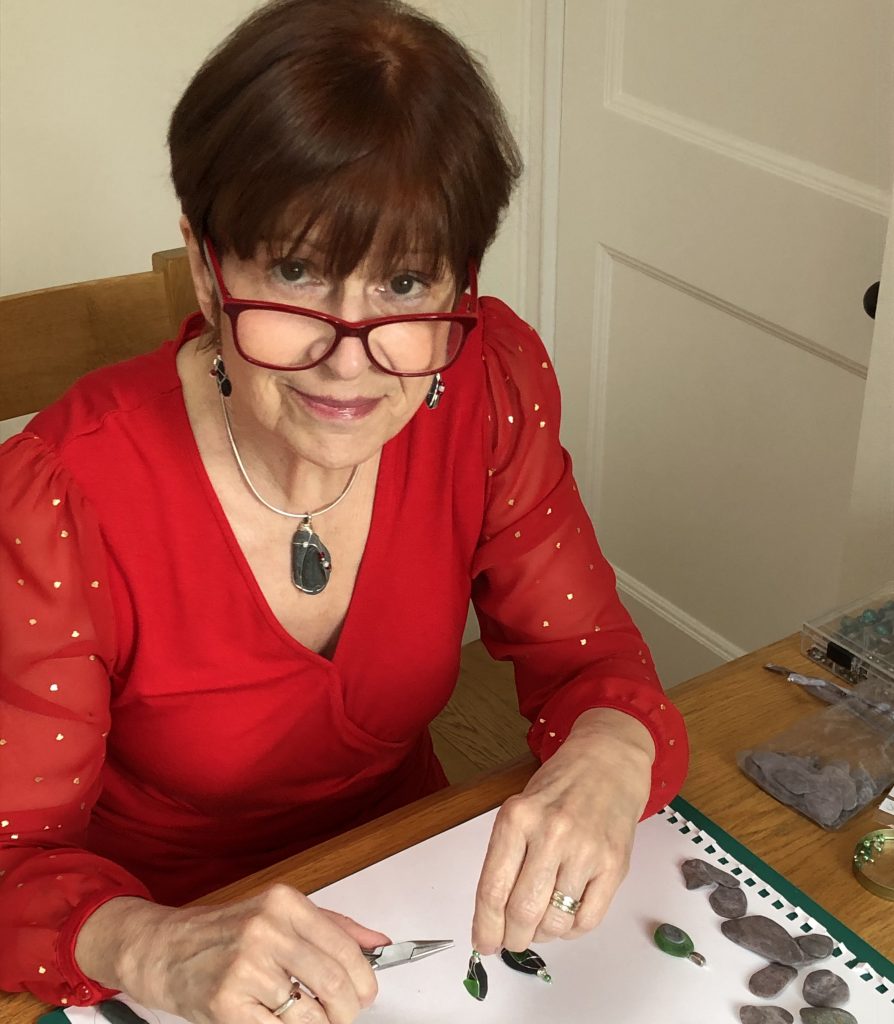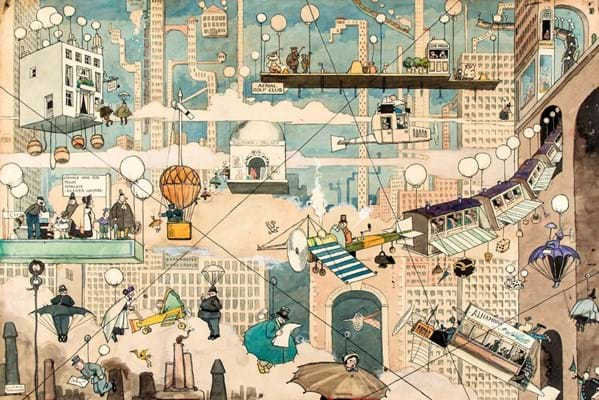The shop of the Heath Robinson Museum has the pleasure to host unique artists, known as Art Makers, and displays their work for sale. Curiosity led me to discover the people hiding behind those pieces of work. I began my adventure by meeting Gillian Pryce, better known as Dil, a self-taught jeweller and passionate creator. I wanted to understand what was inspiring her craft, the story of her blooming passion and the manner in which she keeps nourishing this creative energy.
When I met with Dil for the first time, I saw a beaming, colourful person. The radiance she passed on during our meeting has followed me since then. After a short introduction, she started by showing me her most recent work. I could distinguish a colourful scenery realised by applying fingerprints on the canvas. Her painting style is different this time – usually, she is more precise with patterns and tiny details. At this stage I realise she a resourceful person, looking for newness, pushing her boundaries out of her comfort zone.
Dil is never bored. Each time she takes on a new project, she invents herself all over again just like the lizards she has a fondness for, who moult their old skin into a brand new one as they grow. She paints in the rhythm of the season, by phases, along the stages of life.
A journey in Jewellery and beyond
Dil first discovered jewellery making after participating in a workshop. Since then, she still carries the original tool bag, containing various sizes of pliers, which first helped her journey flourish.
Tiny things are precious to Dil. She is among those who see the discrete beauty in common elements. From the sea glass found on the beach of Spain to stones, the jewels she makes reflects what nature has to offer. Shaped in the deep waters and moulded by the sea, when Dil picks up a stone, she sees this beautiful object fighting with salt, wind, and water.
Usually, the process she follows in making earrings or necklaces goes through the superposition of a smaller stone on a bigger one. The whole piece is tied by a wire keeping them solidly together.
Stones are curious elements, they seem solid, rough and cold with classical shades of colour. Dil knows how to make them talk. Her creation process consists of revealing their secret tenderness, decorating them with light. There is a constraint in this: the smaller stone should fit on the bigger one. Dil lets them find their natural place, according to gravity. She calls her jewels her tiny “Frankensteins”. She says, “the material drives the process” and believes “letting things happen” is the purest freedom of creation and an incantation to life.
Dil is a colour …
Throughout our dialogue, Dil wanted to show me various other works she had done. This was an opportunity to better figure out who she was as an artist. Roaming her house and stopping at different points of interest, I discovered an ode to bold colours and liveliness. If Dil could be herself a colour, she would be a fiery, deep and velvet red – the kind which does not let people be indifferent towards. Dil is definitely no watercolour, she has the incense of someone who takes power from joy and sees life as a gift.
On the corner of a wall, she shows me one of her inspiration, Nichols Canyon Road by David Hockney. This is a cathedral of colours with its blue and purple fields, yellow tree, orange hills. Very enthusiastically, Dil adds that David Hockney is also using techniques of digital painting and drawing. They share the same dynamics of reinventing themselves.
To teach is to play, to play is to create
But Dil is also a former teacher and a passionate one. She has a career as a teacher in a primary school. With children of this age, learning is done through playing and Dil enjoys herself very much. Making for her is a game. By trying something new, exploring other technics, you play with what you have at your disposal. With Dil, art is a great source of fun. Making for her is a game. By trying something new, exploring other technics, you play with what you have at your disposal. With Dil, art is a great source of fun.
Maybe childhood encouraged the flourishing of her passion? She confides to me that hers was full of playing outside, inventions and daydreaming. She learned from young how to nourish her imagination.
When I ask her if she regrets not having been a full-time artist, she told me that in the 50’s and 60’s, the generation of her parents, art was not a job but only a hobby. However, it did not prevent her from fulfilling her longing for artmaking. The need to do something with her hands, to contemplate the product of her imagination, never parted with her.
Sharing art to build bridges between us
To Dil, meaning in life is not only about art. She uses art to communicate and embellish her encounters. She was eager to bond with her grandchildren by sharing her passion. With her granddaughter, now sixteen, they both choose an artist and challenge themselves at replicating their work.
Another of Dil’s inspiration, Grayson Perry, considers art to be deeply social. Communicating about art is a mean of connection to others. It is also a retelling of stories. Dil is touched by the empathy of Grayson Perry and how he associates art-making with the society we are in.
I ask her a final set of questions about the “geography of sharing” and our environment. She praises the cultural dynamism in the London Borough of Harrow. The Pinner sketch club, the Harrow Art Centre and other numerous local artists are elements of a local interest to art and culture. Dil especially sees Pinner as being a potential art platform. To this aim, Dil considers the Heath Robinson Museum essential to the local community, with its activities for children, school groups, and the courses available in the upstairs rooms. Heath Robinson Museum is embodying this vision that “art is sharing”.
The lockdown has been to Dil an opportunity for people to start creating during their free time. Some of them for the first time maybe. Dil is convinced that everyone should take a chance in this regard. As a former teacher, she is convinced that every child, hence every person, has a talent, a stream of inner riches that can come to the surface. Everyone has an ability, being known or not, to express their inner world uniquely. Dil does not distance herself from others. Without a need of recognition and through genuine modesty, Dil says her supporters are just being nice about her work. I admire this simplicity of hers.
Tell me your secret …
We are at the end of our journey and I ask Dil for a last favour. Would she share with me a more personal element – the sole object she would save if, let’s say, her house was to burn down? Her answer is irrevocable. With a cheeky smile, she presents me, her lifelong, faithful and trustworthy teddy bear. The eternal friend for more than half a century: Tootle. Though presenting holes and being stuffed with straw, Dil is attached to each and every part of this earliest remaining symbol of childhood. Still wearing a handmade outfit, Tootle is also a frail scent of a motherly presence. Dil’s mother was in her own way a creator, making clothes for every single doll her daughter had back then.
Haven’t we all this nostalgia of the enchantment a child experiments when discovering the world? Tootle is a reminder of the fragility of time passing by, of the importance of memories and of people who made this life more colourful.
-Judith Spunache


